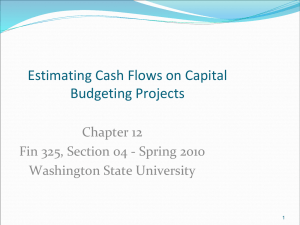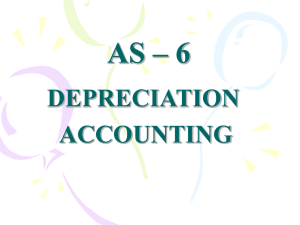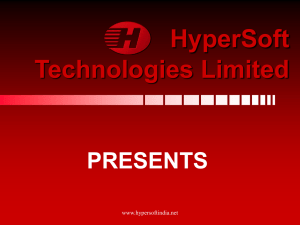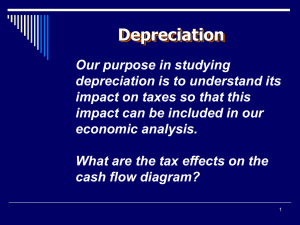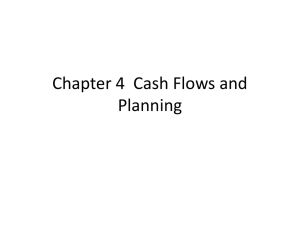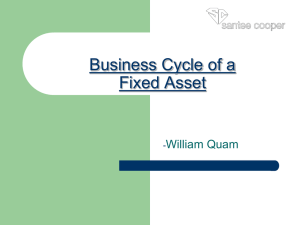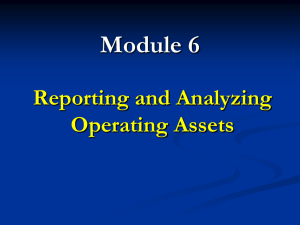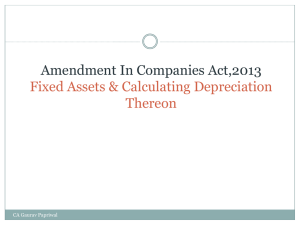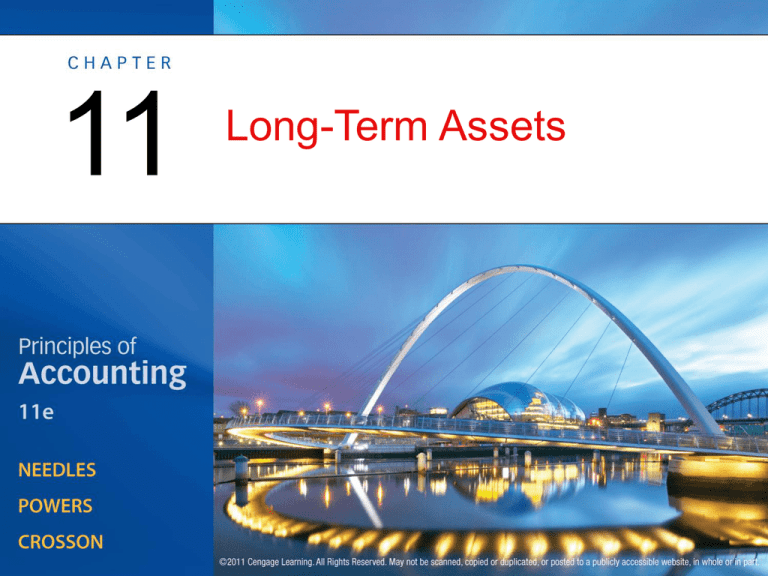
11
Long-Term Assets
Management Issues Related to Long-Term
Assets
OBJECTIVE 1: Define long-term assets, and
explain the management issues related to
them.
Key Ratio
• Free cash flow
Figure 1: Long-Term Assets as a Percentage of
Total Assets for Selected Industries
Figure 2: Classification of Long-Term Assets and
Methods of Accounting for Them
Figure 3: Carrying Value of Long-Term
Assets on the Balance Sheet
Table 1: Illustration of an Acquisition
Decision
Figure 4: Issues in Accounting for LongTerm Assets
Management Issues Related to Long-Term
Assets
• Long-term assets have three characteristics
in common:
– They have a useful life of more than one year.
– They are used in the operation of a business.
– They are not intended for resale to customers.
Management Issues Related to Long-Term
Assets
• Tangible assets consist of property, plant,
equipment, and natural resources.
• Intangible assets consist of patents,
copyrights, goodwill, and the like.
Management Issues Related to Long-Term
Assets
• The major accounting problem is the allocation
of cost (as expenses) to accounting periods.
– Property (not land, however), plant, and equipment
are subject to depreciation.
– Natural resources are subject to depletion.
– Intangible assets are subject to amortization.
Management Issues Related to Long-Term
Assets
• Carrying value (book value) equals cost
less accumulated depreciation.
• All long-term assets are subject to an asset
impairment evaluation.
Management Issues Related to Long-Term
Assets
• A standard measure of a company's capacity to
finance long-term assets is free cash flow (Net
cash flows from operating activities less
dividends and purchases of plant assets plus sales
of plant assets).
Management Issues Related to Long-Term
Assets
• Before investing in plant assets, cash inflows and
outflows are analyzed.
• Accounting for long-term assets requires proper
application of the matching rule by resolving two
issues:
– How much of the total cost to allocate to expense in
the current accounting period
– How much to retain on the balance sheet as an asset
to benefit future periods
©2011 Cengage Learning All Rights Reserved. May not be scanned, copied or duplicate, or posted to a publicly accessible website, in whole or in part.
Acquisition Cost of Property, Plant, and
Equipment
OBJECTIVE 2: Distinguish between capital
expenditures and revenue expenditures, and
account for the cost of property, plant, and
equipment.
Acquisition Cost of Property, Plant, and
Equipment
• An expenditure (a payment or incurrence of a
liability) is one of two types.
– A capital expenditure benefits more than one period
and is recorded as an asset.
– A revenue expenditure benefits only the current
period and is expensed.
Acquisition Cost of Property, Plant, and
Equipment
• Additions and betterments (improvements) are
capital expenditures and are debited to an asset
account.
• Extraordinary repairs increase an asset’s residual
value or useful life. These capital expenditures
are debited to accumulated depreciation.
Acquisition Cost of Property, Plant, and
Equipment
• Errors in properly classifying expenditures result
in misstatements in assets and net income of the
current and future periods.
Acquisition Cost of Property, Plant, and
Equipment
• The cost of a long-term asset includes the
purchase cost, freight, installation, insurance
while in transit, and any other costs required
prior to operation.
– The cost of land includes real estate commissions,
lawyers’ fees, accrued taxes paid by the buyer, razing
a building, draining, clearing, grading, assessments,
and landscaping.
– Land improvements include driveways, parking lots,
fences, and signs.
Acquisition Cost of Property, Plant, and
Equipment
• The cost of a long-term asset includes the
purchase cost, freight, installation, insurance
while in transit, and any other costs required prior
to operation.(cont.)
– The cost of buildings purchased includes the purchase
price and repairs to make the building usable.
– The cost of an asset constructed includes materials,
labor, overhead, architects’ and lawyers’ fees,
insurance during construction, and interest on a
construction loan.
Acquisition Cost of Property, Plant, and
Equipment
• The cost of a long-term asset includes the
purchase cost, freight, installation, insurance
while in transit, and any other costs required
prior to operation.(cont.)
– The cost of equipment includes the invoice price less
cash discounts, freight, insurance, taxes, tariffs,
buying expenses, installation costs, and test runs.
– Interest on a loan to purchase an asset is expensed.
Interest on a construction loan is capitalized.
Acquisition Cost of Property, Plant, and
Equipment
• The cost of a long-term asset includes the
purchase cost, freight, installation,
insurance while in transit, and any other
costs required prior to operation.(cont.)
– All plant assets except land (i.e., land
improvements, buildings, equipment) are
depreciated.
Acquisition Cost of Property, Plant, and
Equipment
• Leasehold improvements are amortized
over the remaining term of the lease or the
useful life of the improvement, whichever
is shorter.
• When a lump-sum purchase is made, the
cost is allocated based on the assets’
relative fair market values.
©2011 Cengage Learning All Rights Reserved. May not be scanned, copied or duplicate, or posted to a publicly accessible website, in whole or in part.
Depreciation
OBJECTIVE 3: Compute depreciation under
the straight-line, production, and decliningbalance methods.
Table 2: Depreciation Schedule, StraightLine Method
Table 3: Depreciation Schedule,
Production Method
Table 4: Depreciation Schedule, DoubleDeclining-Balance Method
Figure 5: Graphic Comparison of Three
Methods of Determining Depreciation
Figure 6: Depreciation Methods Used by 600
Large Companies for Financial Reporting
Depreciation
• Depreciation is the logical allocation of
asset cost to the periods that benefit from
the services of that asset.
– Depreciable assets have limited useful lives
because of physical deterioration and
obsolescence.
Depreciation
• Several factors affect the computation of
depreciation.
–
–
–
–
Cost
Residual (salvage) value
Depreciable cost
Estimated useful life (in time or in units)
Depreciation
• List the three most common methods of
depreciation.
– The straight-line method (based on the passage of
time)
• The formula for the straight-line method:
C ost R esidual V alue
E stim ated U seful Life (in years)
Depreciation
– The production method (based on units produced,
miles driven, and the like)
• The formula for the production method:
C ost R esidual V alue
E stim ated U seful of U seful L ife
Depreciation
– The declining-balance method (an accelerated method)
• The double-declining-balance formula:
R em aining C arrying V alue
100%
2
U seful Life (in years)
– The production method is a good application of the
matching principle, but it can be used only if output
over useful life can be estimated with reasonable
accuracy.
Depreciation
• List the three most common methods of
depreciation. (cont.)
– Residual value is ignored initially, but an asset
may not be depreciated below its residual
value.
– Compare the three depreciation methods by
referring to Figure 5 in the text.
Depreciation
• Special issues in depreciation
– Group depreciation saves time by depreciating
a group of similar assets as a whole.
Depreciation
• Special issues in depreciation (cont.)
– When an asset is owned for less than a year,
only a partial year’s depreciation should be
taken.
• Under the half-year convention, one-half year’s
depreciation is recorded in the year of purchase and
one-half year’s depreciation is recorded in the year
of disposition.
Depreciation
• Special issues in depreciation (cont.)
– After an asset has been put into use, its
estimated useful life or residual value may be
revised.
• Leave the previously taken depreciation unchanged.
• Revise the useful life or residual value.
• Allocate the remaining depreciable cost over the
remaining useful life.
Depreciation
• Special issues in depreciation (cont.)
– Accelerated cost recovery allows companies to
take rapid write-offs of plant assets for tax
purposes. This method is usually not
acceptable for financial reporting purposes.
©2011 Cengage Learning All Rights Reserved. May not be scanned, copied or duplicate, or posted to a publicly accessible website, in whole or in part.
Disposal of Depreciable Assets
OBJECTIVE 4: Account for the disposal of
depreciable assets.
Disposal of Depreciable Assets
• An asset is disposed of when it is
discarded, sold, or traded in.
• Record depreciation for the period
preceding disposal.
Disposal of Depreciable Assets
• Journalize the disposal of an asset.
– Debit Accumulated Depreciation and credit the
asset account.
– Debit any receipt of cash.
– Debit or credit a loss or gain on disposal if cash
received differs from the carrying value.
– Credit asset for recorded cost.
Disposal of Depreciable Assets
• Account for the exchange of similar assets.
– For financial accounting purposes, losses are
recognized, but gains are not.
– For tax purposes, neither gains nor losses are
recognized.
• Account for the exchange of dissimilar
assets.
– Both gains and losses are recognized for both
reporting and tax purposes.
Disposal of Depreciable Assets
Disposal of Depreciable Assets
Disposal of Depreciable Assets
Disposal of Depreciable Assets
©2011 Cengage Learning All Rights Reserved. May not be scanned, copied or duplicate, or posted to a publicly accessible website, in whole or in part.
Natural Resources
OBJECTIVE 5: Identify the issues related to
accounting for natural resources, and
compute depletion.
Natural Resources
• Depletion
– The allocation of the cost of a natural resource
over the periods benefited.
– Compute depletion, using the depletion
formula.
– Units extracted but not sold are recorded as
inventory.
Natural Resources
• Tangible assets used with natural resources
should be depreciated over the shorter of
the life of the tangible asset or the life of
the natural resource.
Natural Resources
• There are two methods of accounting for oil
and gas development and exploration costs.
– Under successful efforts accounting, only the
cost of productive wells is capitalized.
– Under the full-costing method, the cost of all
wells is capitalized.
Natural Resources
©2011 Cengage Learning All Rights Reserved. May not be scanned, copied or duplicate, or posted to a publicly accessible website, in whole or in part.
Intangible Assets
OBJECTIVE 6: Identify the issues related to
accounting for intangible assets, including
research and development costs and
goodwill.
Table 5: Accounting for Intangible Assets
Figure 7: Intangible Assets Reported by
600 Large Companies
Intangible Assets
• Intangible assets (list examples) represent
rights and privileges extended to their
owner.
• Other than goodwill, intangible assets
usually are capitalized and expensed over
their useful lives (not to exceed 40 years) in
accordance with the matching rule.
Intangible Assets
• Research and development costs are
expensed.
• Computer software costs are expensed until
a product has been proved to be
technologically feasible, then they are
capitalized.
Intangible Assets
• Goodwill is the excess of the purchase cost
over the fair market value of the net assets
purchased.
– Goodwill usually is estimated based on
superior past earnings.
– For financial reporting purposes, goodwill is an
asset to be reported as a separate line item on
the balance sheet and is subject to an annual
impairment review.
©2011 Cengage Learning All Rights Reserved. May not be scanned, copied or duplicate, or posted to a publicly accessible website, in whole or in part.


